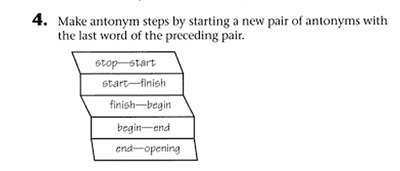Here’s an interesting vocabulary puzzle for your students to explore. The idea comes from a quick mention in The Teacher’s Book of Lists (a book packed with quick mentions of amazing ideas).

I thought it was so cool, I spent a day or so working up examples and some guidelines to keep it interesting for students. I also decided to name it “Antonym Paths.”
The Steps
Begin with a small, simple word and identify its antonym. Then, take this second word and find its antonym. Many times, you’ll find that an antonym of an antonym isn’t always related the original word. Keep going, trying to find antonyms that make the path turn in unexpected ways. Here’s an example:
- easy
- hard
- soft
- loud
- quiet
At each step, the path twists in a new direction. And there are often multiple paths from the same starting word.
- easy
- tough
- tender
- overcooked
- raw
Unexpected twists? Multiple right answers? This sounds like a perfect way to add complexity to vocabulary!
Guidelines
This activity will work best if you simply give students a starting word and ask them to create a path. Give them time, too. This is a complex task and will require thinking and perhaps consulting a thesaurus.
The path should be at least four steps long to be interesting. Encourage students to explore truly different words, not just shades of meaning. The path should really wander.
| Non Example | Example |
|---|---|
| 1. easy | 1. easy |
| 2. hard | 2. hard |
| 3. simple | 3. simple |
| 4. difficult | 4. gaudy |
| 5. modest | |
| 6. boastful |
Encourage creativity and clever thinking over perfect adherence to the rules.
For example, in this sequence, the jump from “different” to “like” kinda works, but it opens up such a great new avenue that I’d allow it, although I’d mention that it does only kinda work.
- same
- different
- like
- hate
- love
More Antonym Path Examples
From “lie” to “spring:”
- lie
- stand
- sit
- rise
- Fall
- Spring
From “slow” to “food”:
- slow
- fast
- eat
- drink
- food
From “thin” to “sit”:
- thin
- fat
- lean
- stand
- sit
Adding Structure
If you wanted, you could give a starting and beginning word and see if students can create a path between them, much like Word Ladders:
| Show Students | One Solution |
|---|---|
| 1. young | 1. young |
| 2. __ | 2. old |
| 3. __ | 3. new |
| 4. __ | 4. used |
| 5. mint | 5. mint |
Have fun with this one and let me know how you adapt it for your kids!
